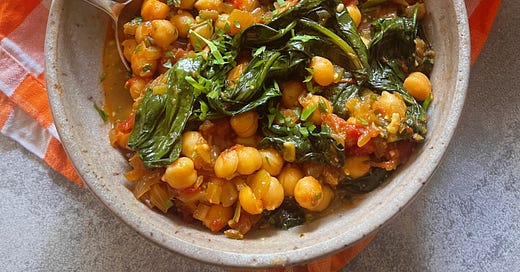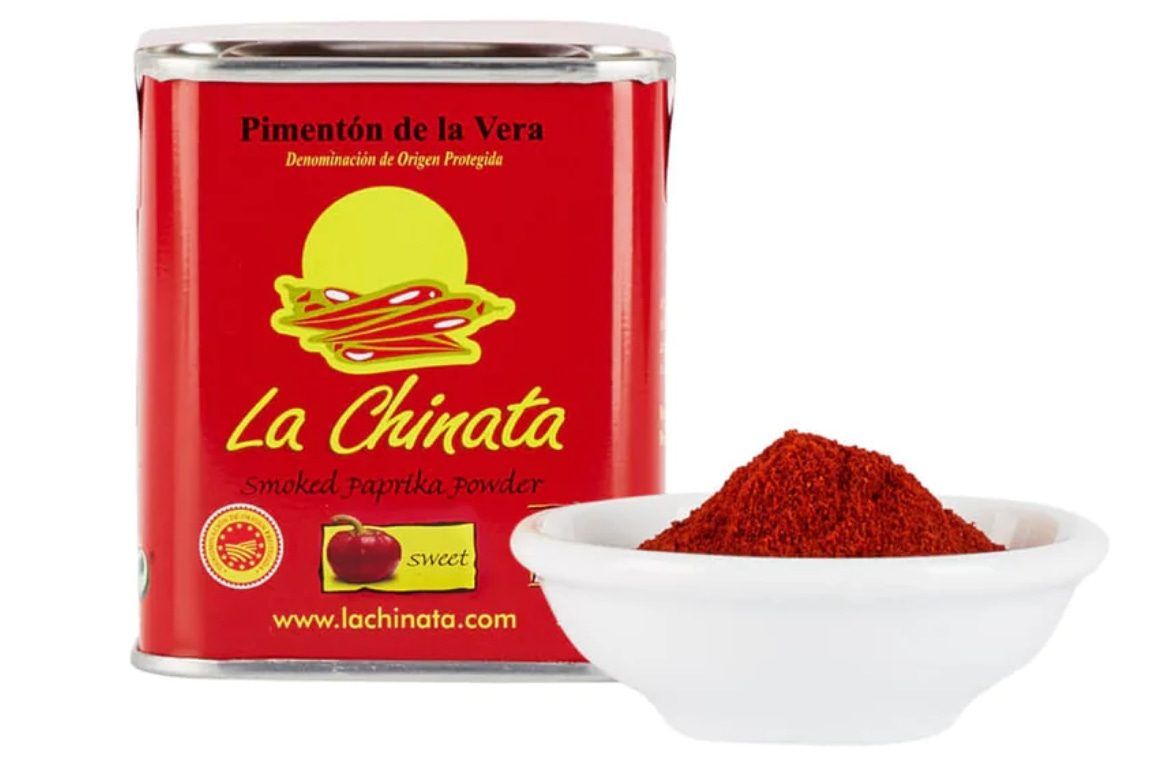The Lunchbox #10, The Spanish Issue 🇪🇸
I'm just back from Barcelona and I'm full of Spanish Spirit(s)
What I’m currently consuming
The Sauce: Chovi Allioli
There’s really nothing easier than making you own allioli (known as aioli to the rest of us), BUT if you’re short of time and need your garlic fix, this is your guy. It’s the most popular brand in Spain and it’s easy to see why. Don’t be fooled by the bright and breezy packaging; the contents is all business. It packs a serious punch and yet it’s beautifully balanced. And impossible to stop eating. Brilliant as a dip, but also - my god - this in a sandwich with tomato and sliced egg. Perfect. (You can find it at Co-op, Morrisons, Asda and Amazon).
The Tuna: Ortiz
I’m sure most of you don’t need telling about this company. The iconic yellow, blue and red packaging sits on the shelves of most fancy food shops. But here’s a reminder - it’s top-notch fish in a tin. In a world where you often can’t trust the heritage of your tuna, it’s reassuring to know they use the bonito, a smallish, sustainable tuna usually weighing less than 20kg. All the fish Ortiz buy is caught on rod and line in the Bay of Biscay and then processed by hand. This means it ain’t cheap, but you get what you pay for (and is a perfect opportunity to follow the mantra ‘eat less meat, eat better meat’?). The fish is perfectly poached, delicately seasoned and sits under a layer of actually pretty good olive oil. It doesn’t need much, just a little pepper and a squeeze of lemon and it’s good to go. I’m not going to bore you by going into how much I love their anchovies, that’s for another day. But I really do.
💥HOT TIP: The Ortiz tins (small and large) should never be thrown away - recycle them and use as tupperware, butter dishes, herb pots, change holders, a little bed for your pet hamster…
The Spice: Pimentón de la Vera
This is one of the staple spices in the Spanish store-cupboard, found in many of our favourite Spanish dishes, such as paella, patatas bravas and chorizo. And I don’t know about you, but I have always been confused about the different types. So here’s a quick run-down:
🌶️ The basic supermarket stuff is worth avoiding. It’s mild, one-dimensional and more about the colour than flavour.
🌶️ Hungarian paprika is as revered as the Spanish variety and comes in eight different flavour profiles, from mild + bright red, to spicy + pungent, to mild, pale orange.
🌶️ The Spanish version, Pimentón de la Vera is made from ground red peppers grown in the Extremadura region in south-west of Madrid. The paprika peppers are oak-smoked, then ground in stone mills to keep temperatures low and retain natural characteristics. It come in three types and is almost always smoked and spicy, but to varying degrees. There’s dulce, agridulce and picante, or sweet, medium and hot, respectively. The sweet variety is mostly used with light meat, such as octopus, rabbit or chicken. The hot variety is used in heartier winter soups and stews and in the production of chorizo sausages.
Wanna know what else I brought back with me? Full Spanish supermarket haul can be admired here.
Something to fill you up
Spanish Chickpea & Spinach Stew
Aka Garbanzoles con Espinacas
This was one of my favourite vegetable dishes I encountered. It’s a simple Catalan stew elevated to glorious heights by the addition of a picada at the end. This is a thick, crunchy paste traditionally made with golden fried garlic, almonds, parsley and sometimes bread. It’s used to add depth of flavour and punch up simple dishes. I love what it does to this dish; tickling the tomato sauce and subtly adding creaminess and a note of deep, fried garlic.
This dish is wonderfully good for you, packed with protein, fibre and iron. Oh yeah, and it’s vegan too, as well as using affordable, store-cupboard ingredients and being a total cinch to make. Soaking + cooking your own chickpeas makes this even better (and cheaper), but if not, I highly recommend these ladies (as featured last Lunchbox)
Watch my how-to video here
Serves 4
3 tbsp olive oil
25g blanched almonds
3 garlic cloves, whole and peeled
2 handfuls of parsley, chopped
1 onion, chopped
1 tsp sweet paprika
1/2 tsp ground cumin
1 tsp fennel seeds
1 x 400g tin tomatoes, rinsed or 4 medium tomatoes, chopped
1 tbsp sherry vinegar
400g cooked chickpeas
450ml vegetable stock or water
A big pinch of saffron threads
150g spinach, washed
Place a medium pan over a medium heat and warm up the olive oil. Once hot, add the almonds and garlic and gently fry, stirring until they’re golden brown, then scoop into a pestle and mortar or small blender along with a pinch of salt. Grind to a crunchy paste, adding the parsley at the end and crushing until it’s nice and green. Put to one side.
Add the onion to the pan (there should be enough oil remaining, but add more if necessary) along with a pinch of salt, return to a medium heat and fry for 10 minutes until soft and just colouring.
Add the paprika, cumin and fennel seeds and and once they’re just warmed through, add the tomatoes, breaking them up with your spoon as they go in.
Fry for another 5 minutes until the sauce is slightly reduced, then add the chickpeas, stock, saffron and another pinch of salt and simmer for another 10 minutes to bring everything together.
Fold the spinach leaves into the pan, stirring until it wilts (you can put a lid on if that’s easier). Take off the heat and stir in the picada. Transfer to bowls and eat with bread and salad.
Something to finish you off
I’ve returned from my travels as the self-appointed president of the flan fan club. It delivers exactly what you require from an end-of-meal dessert, hitting that sweet spot but not leaving you feeling hyped-up on sugar or run-over by richness. It’s light, creamy and has just the right amount of sugar. I came home with several packets (see below) of this super-quick mix (just 7 minutes of stirring!) but this is a recipe I’ve made before and love because it uses whole milk instead of cream and is wonderfully easy.
10 things the Spanish know better than us
1. Breakfast (el desayuno) is a dull meal, much better to wait for a mid morning snack (almuerzo) of a sweet bun or small sandwich and coffee.
2. Lunch (la comida) should be the principle meal of the day and be a big, social, leisurely affair, eaten late at 1.30-3.30 pm. It’s often a three course meal, including wine and bread and can last for some time.
3. But don’t worry about going back to work after - take an afternoon siesta instead. Most of the country shuts up shop between 1.30-4.30pm to make this happen.
4. Dinner should be eaten later too, usually 9pm-midnight and can be a bit lighter and simpler than lunch. You don’t want to fill up; there’s more drinking to be done!
5. This is a reasonable daily drinking schedule:
08:00: cafe con leche (equal parts coffee and milk)
12:30: vermouth
14:00: dry sherry
15:00: a small glass of beer
17:00: un cortado (an espresso with a tiny dash of milk)
23:30: a gin and tonic or similar post dinner drink.
6. Sangria is for foreigners.
7. Tapas isn’t something you sit down at a table and order. It’s eaten standing up, moving from bar to bar, with friends, either before lunch or for dinner.
8. Paella is a lunchtime dish, actually refers to the cooking pan (not the food), does not traditionally contain chorizo and should NEVER be consumed at an establishment that offers it for one person - the secret to great paella is the surface area of the wide pan.
9. Night owls have more fun than early birds. Bedtime is often at midnight during the week, 3am during weekends, the holidays and summer months.
10. Food is all about bringing people together. It’s a social experience, not something you rush or do on the street/at your desk/in your car.They don’t believe in doggy bags because it doesn’t make sense to them - why wouldn’t you just stay and eat your food? There’s a lot to be learnt from the guys.














